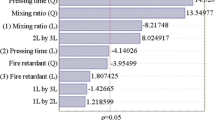Abstract
The effects of using 100% black spruce (Picea mariana) bark fibers as core layer material accounting for up to 70% of the board and its resin content (between 6 and 10%) on the properties of three-layer medium-density fiberboard (MDF) were investigated using a full factorial experimental design with two independent variables and three levels. Five response variables, namely internal bond strength, modulus of rupture, modulus of elasticity, thickness swelling and water absorption were statistically analyzed using a response surface methodology and two-way analysis of variance. The effects of the proportion of core layer (bark fibers) and its resin content on panel properties were significant. All properties studied were positively affected by increasing core layer resin content. The effects of the proportion of core layer (bark fibers) on mechanical properties and water absorption were negative, but positive on thickness swelling. Simultaneous optimization of panel properties indicated that at a density of 850 kg/m3, a three-layer MDF with a core layer resin content of 6.5%, a face resin content of 12 and 60% of core layer proportion (spruce bark fibers) would satisfy the minimum requirements of ANSI standard for 130-grade MDF. Overall, black spruce bark, a major residue source in the Eastern Canada, should be considered as a supplemental furnish for the core layer materials of a three-layer MDF.





Similar content being viewed by others
References
American National Standards Institute (ANSI) (2002) Medium density fiberboard (MDF) for interior application. ANSI A208.2-2002. Composite Panel Association, Gaithersburg, MD
American Society of Testing and Materials (ASTM) (2001) Evaluating properties of wood-based fiber and particle panel materials. ASTM D 1037-99. ASTM, Philadelphia, PA
Anderson AB, Wu KT, Wong A (1974) Utilization of ponderosa pine bark and its extractives in particleboard. For Prod J 24(8):48–53
Blanchet P, Cloutier A, Riedl B (2000) Particleboard made from hammer milled black spruce residues. Wood Sci Technol 34(1):11–19
Box GEP, Wilson KB (1951) On the experimental attainment of optimum conditions. J Roy Stat B13:1–45
Chow P (1976) Properties of medium-density, dry-formed fiberboard from seven hardwood residues and bark. For Prod J 26(5):48–55
Dost WA (1971) Redwood bark fiber in particleboard. For Prod J 21(10):38–43
Einspahr DW, Harder M (1975) Hardwood bark properties. Important to the manufacture of fiber products. For Prod J 26(6):28–31
Gertjejansen R, Haygreen J (1973) The effect of aspen bark from butt and upper logs on the physical properties of wafer-type and flake-type particleboards. For Prod J 23(9):66–71
Hsu WE (1993) Cost-effective PF-bonded fiberboard. In: Proceedings of 12th particleboard symposium. Washington State University, Pullman, WA, pp 155–166
Lehmann WF, Geimer RL (1976) Properties of structural particleboards from Douglas-fir forest residues. For Prod J 24(10):17–25
Maloney TM (1973) Bark boards from four west coast softwood species. For Prod J 23(8):30–38
Maloney TM (1993) Modern particleboard and dry-process fiberboard manufacturing. Miller Freeman Publications, San Francisco, CA, USA, 681 p
Muszynski Z, McNatt JD (1984) Investigation on the use of spruce bark in the manufacture of particleboard in Poland. For Prod J 34(1):28–35
Olson BD (1996) Developing wood composites using small diameter timber resources from dense, stagnant stands. MS Thesis. Washington State University, Pullman, WA
Park BD, Riedl B, Hsu WE, Shields J (1999) Hot-pressing process optimization by response surface methodology. For Prod J 49(5):62–68
Peter JJ, Bender DA, Wolcott MP, Johnson JD (2002) Selected properties of hybrid poplar clear wood and composite panels. For Prod J 52(5):45–54
Place TA, Maloney TM (1976) Internal bond and moisture response properties of three-layer, wood-bark boards. For Prod J 27(3):50–54
Shi JL, Zhang SY, Riedl B (2005) Effect of juvenile wood on strength properties and dimensional stability of black spruce medium density fiberboard panels. Holzforschung 59:1–9
Smith JHG, Kozak A (1967) Thickness and percentage of bark of the commercial trees of British Columbia. Faculty of forestry, University of British Columbia, Vancouver, 27 p
Stuart DL, Butler DL (1968) Hardboard from cedar bark. For Prod J 18(12):19–23
Volz KR (1973) Production and properties of boards from spruce, pine, and beech bark. Holz Roh-Werkst 31(6):221–229
Wisherd KD, Wilson JB (1979) Bark as supplement to wood furnish for particleboard. For Prod J 29(2):35–39
Woodson G (1975) Effects of bark, density profile, and resin content on medium density fiberboards from southern hardwoods. For Prod J 26(2):39–42
Xing C, Deng J, Zhang SY, Riedl B, Cloutier A (2006a). Impact of bark content on the properties of medium density fiberboard (MDF) in four species grown in eastern Canada. For Prod J 56(3):64–69
Xing C, Deng J, Zhang SY (2006b) Effect of thermo-mechanical refining on the property of MDF made from Black Spruce bark. Wood Sci Technol (online first doi:10.1007/s00226-006-0108-3)
Xing C, Riedl B, Cloutier A, Deng J, Zhang SY (2006c) UF resin efficiency as affected by resin loss, distribution and pre-cure. Holz Roh- Werkst 64(3):221–226
Xing C, Deng J, Zhang SY, Riedl B, Cloutier A (2006d) MDF performance as affected by wood fiber buffering capacity, pH and fiber size distribution. Wood Sci Technol 40(8):637–646
Author information
Authors and Affiliations
Corresponding author
Rights and permissions
About this article
Cite this article
Xing, C., Zhang, S.Y., Deng, J. et al. Investigation of the effects of bark fiber as core material and its resin content on three-layer MDF performance by response surface methodology. Wood Sci Technol 41, 585–595 (2007). https://doi.org/10.1007/s00226-007-0129-6
Received:
Published:
Issue Date:
DOI: https://doi.org/10.1007/s00226-007-0129-6




